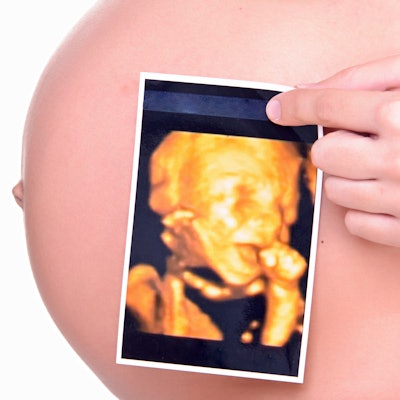
Can second-trimester ultrasound screening for fetal growth restriction (FGR) reliably predict if a baby will go on to have a low birth weight for his or her gestational age? Not in most cases, according to recent research from Vanderbilt University Medical Center in Nashville, TN.
After performing a retrospective review of patients diagnosed with FGR on screening ultrasound scans over a two-year period, the researchers found that only a little over one-third of neonates wound up having a birth weight that was small for their gestational age. What's more, more than 85% of babies diagnosed prenatally with FGR were delivered at or beyond 34 weeks of gestational age.
"Pregnancies complicated by [a diagnosis of] fetal growth restriction resulted in normally grown neonates and term deliveries in the majority of cases," said first author Dr. Amanda Craig, a resident physician at Vanderbilt. "Patients may be receiving additional ultrasounds and premature or unnecessary courses of steroid therapy."
Craig presented the research at the American Institute of Ultrasound in Medicine (AIUM) annual meeting in New York City.
Clinically significant diagnosis
Considered a clinically significant diagnosis, fetal growth restriction is defined as having an estimated fetal weight less than the 10th percentile for a given gestational age and is associated with an increased risk of adverse neonatal outcomes. Fetuses with undiagnosed FGR have a significantly higher risk of stillbirth and neonatal mortality, Craig said.
 Dr. Amanda Craig of Vanderbilt University Medical Center.
Dr. Amanda Craig of Vanderbilt University Medical Center."Therefore identifying those at risk has clinical significance," she said. "[However], there lacks a consensus regarding the best screening and management practices for pregnancies affected by fetal growth restriction."
While current guidelines recommend screening for FGR using fundal height measurements performed by healthcare providers, this approach has been reported in the literature to yield a sensitivity of 65% to 85% depending on maternal characteristics. Other studies have shown that the routine use of ultrasound as a screening method for FGR could improve detection rates by 46% to 80%, but they did not find an effect on overall perinatal morbidity and mortality, she said.
Furthermore, an incorrect diagnosis of FGR is associated with higher rates of labor induction, cesarean delivery, and short-term adverse neonatal outcomes.
To describe the clinical impact of screening ultrasound scans in pregnancies with FGR, the Vanderbilt researchers retrospectively reviewed all pregnancies diagnosed with FGR between 2014 and 2016 at their institution that had received a first- or second-trimester scan with confirmation of ultrasound dating. Cases with fetal structural anomalies or a chromosomal abnormality were excluded. The final study included a total of 406 pregnancies.
The majority (63.5%) of the maternal population was Caucasian and 44% of the mothers were classified as obese, Craig said. Specifically, the researchers were interested in four outcomes: additional ultrasound scans performed during pregnancy, premature steroid administration, infants being small for gestational age following FGR diagnosis, and fetal demise or neonatal death.
The median gestational age at the first growth ultrasound scan was 25 weeks. The majority of women had either two (20.4%), three (26.8%), or four (29%) fetal growth ultrasound scans during their pregnancies. In addition, 19% of the women had five or more scans, Craig said. The median total number of all ultrasound exams during each pregnancy was eight.
Limited effect?
Only 142 (35%) of the neonates were small for gestational age at the time of birth, while the remaining 264 (65%) had birth weights greater than the 10th percentile, according to the researchers. In addition, 86% of the babies were delivered at or beyond 34 weeks; only 3% were delivered before 28 weeks. There were 14 cases (3.4%) of neonatal demise and six cases (1.5%) of fetal demise; the 4.9% demise rate is similar to national rates reported in the literature, Craig said.
Of the 406 patients in the study, 114 (28%) had received a course of antenatal steroids, according to the researchers. The median gestational age at the initial course of steroids was 30 weeks (range: 26.25 to 32 weeks), with a median of 21 days (range: 3 to 46.75 days) until delivery following administration. Furthermore, 21 (18%) of the patients were given a second "rescue course" of steroids; all remained pregnant more than seven days after completing rescue steroids without an indication of delivery or onset of labor, she said.
Complications
In other findings, all neonatal complications were more likely (p < 0.05) in cases of earlier gestational age at delivery, with the exception of transient tachypnea of the newborn. The most common neonatal complications were as follows:
- Admission to neonatal intensive care unit: 34%
- Hyperbilirubinemia: 27%
- Hypothermia: 12%
- Respiratory distress syndrome: 10%
There were no significant differences in outcomes based on neonatal sex, Craig said.
Further studies are needed to determine if screening growth ultrasound and related interventions significantly alter the risks of fetal and neonatal demise, as well as which patients benefit from such screening, she said.




















